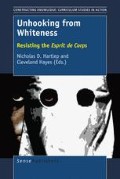Abstract
The most frequent comment in the area of teaching is that Cleveland does not display the college’s dispositions of respectfulness and professionalism. Faculty members remarked on Cleveland’s frequent comments on his disdain for college committees and for the teacher education faculty. The faculty feels that his unwillingness to display the agreed upon dispositions is very problematic. His problematic relationships have limited his effectiveness in the areas of teaching and advising. I do not recommend him for tenure.
Access this chapter
Tax calculation will be finalised at checkout
Purchases are for personal use only
Preview
Unable to display preview. Download preview PDF.
References
Camper, C. (1994). To white feminists. Canadian Woman Studies, 14(2), 40–42.
DeCuir, J. T., & Dixson, A. D. (2004). “So when it comes out, they aren’t that surprised that it is there”: Using critical race theory as a tool of analysis of race and racism in education. Educational Researcher, 33(5), 26–31.
Delgado Bernal, D., & Solórzano, D. (2001). Examining transformational resistance through a critical race and LatCrit theory framework: Chicana and Chicano students in an urban context. Urban Education, 36(3), 308–342.
Delgado, R. (1995). Critical race theory: The cutting edge. Philadelphia, PA: Temple University Press.
Delgado, R., & Stefancic, J. (2001). Critical race theory: An introduction. New York, NY: Temple University Press.
Dixson, A. D., & Rousseau, C. K. (2006). Critical race theory in education: All god’s children got a song. New York, NY: Routledge.
Douglas, K., & Carless, D. (2013). A history of autoethnographic inquiry. In S. H. Jones, T. E. Adams, & C. Ellis (Eds.), Handbook of autoethnography (pp. 84–107). Walnut Creek, CA: Left Coast Press.
Fasching-Varner, K. J. (2009). No! The team ain’t alright! The institutional and individual problematic of race. Social Identities, 15(6), 811–829.
Gaskins, A. (2006). Putting the color in Colorado: On being black and teaching ethnic studies at the University of Colorado-Boulder. In C. E. Stanley (Ed.), Faculty of color: Teaching in predominantly white college and universities (pp. 139–152). Boston, MA: Anker Publishing Company.
Harris, C. (1995). Whiteness as property. In K. Crenshaw, N. Gotanda, G. Peller, & K. Thomas (Eds.), Critical race theory: The key writings that formed the movement (pp. 276–291). New York, NY: The New Press.
Hayes C., & Juárez, B. G. (2009). You showed your whiteness: You don’t get a “good” White people medal. International Journal of Qualitative Studies in Education, 22(6), 729–744.
Juárez, B. G., & Hayes, C. (2015). Too black, yet not black enough: Challenging white supremacy in U.S. teacher education and the making of radical social misfits. In F. Briscoe & M. Khalifa (Eds.), Becoming critical: Oppression, resistance and the emergence of a critical educator/researcher (pp. 71–94). Albany, NY: State University of New York Press.
Knight, M., Norton, N., Bentley, C., & Dixon, I. (2004). The power of Black and Latina/o counterstories: Urban families and college-going processes. Anthropology and Education Quarterly, 35(1), 99–120.
Kozol, J. (1991). Savage inequalities. New York, NY: Crown Publishers.
Ladson-Billings, G. (1998). Just what is critical race theory and what is it doing in a nice field like education? International Journal of Qualitative Studies in Education, 11(1), 7–24.
Lee, S. J. (1996). Unraveling the model minority: Listening to Asian American youth. New York, NY: Teachers College Press.
Leonardo, Z. (2009). Race, whiteness, and education. New York, NY: Routledge.
Lewis, A. E. (2006). Race in the schoolyard: Negotiating the color line in classrooms and communities. New Brunswick, NJ: Rutgers University Press.
Love, B. J. (2004). Brown plus 50 counter-storytelling: A critical race theory analysis of the Majoritarian achievement gap story. Equity & Excellence in Education, 37(3), 227–246.
MacLeod, J. (1997). Ain’t no makin’ it: Aspirations and attainment in a low income neighborhood. San Francisco, CA: Westview Press.
McCray, A., Sindelar, P., Kilgore, K., & Neal, L. (2002). African American women’s decisions to become teachers: Sociocultural perspectives. Qualitative Studies in Education, 15(3), 269–290.
McIntosh, P. (1989, July/August). Unpacking the invisible knapsack. Peace and Freedom Magazine, 10–12.
Payne, R. K. (1998). A framework for understanding poverty (3rd Rev. ed.). Highlands, TX: Aha! Process, Inc.
Pierce, C. (1974). Psychiatric problems of the Black minority. In S. Arieti (Ed.), American handbook of psychiatry (pp. 512–516). New York, NY: Basic Books.
Solórzano, D., & Yosso, T. (2002). Critical race methodology: Counter-storytelling as an analytical framework for education research. Qualitative Inquiry, 8(1), 23–44.
Tate, W. F. (2003). The “race” to theorize education: who is my neighbor?. International Journal of Qualitative Studies in Education, 16(1), 121–126.
Valdes, G. (1996). Con respecto: Bridging the distances between culturally diverse families and schools. New York, NY: Teachers College Press.
West, C. (1994). Race matters. New York, NY: Random House.
Yosso, T. J. (2006). Critical race counterstories along the Chicana/Chicano educational pipeline. New York, NY: Routledge.
Editor information
Editors and Affiliations
Rights and permissions
Copyright information
© 2016 Sense Publishers
About this chapter
Cite this chapter
Hayes, C. (2016). Unhooking from Whiteness and the Assault that Follows. In: Hartlep, N.D., Hayes, C. (eds) Unhooking from Whiteness. Constructing Knowledge. SensePublishers, Rotterdam. https://doi.org/10.1007/978-94-6300-527-2_2
Download citation
DOI: https://doi.org/10.1007/978-94-6300-527-2_2
Publisher Name: SensePublishers, Rotterdam
Online ISBN: 978-94-6300-527-2
eBook Packages: EducationEducation (R0)

